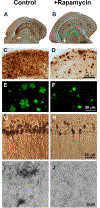How longevity research can lead to therapies for Alzheimer's disease: The rapamycin story
- PMID: 25481271
- PMCID: PMC6417920
- DOI: 10.1016/j.exger.2014.12.002
How longevity research can lead to therapies for Alzheimer's disease: The rapamycin story
Abstract
The discovery that rapamycin increases lifespan in mice and restores/delays many aging phenotypes has led to the speculation that rapamycin has 'anti-aging' properties. The major question discussed in this review is whether a manipulation that has anti-aging properties can alter the onset and/or progression of Alzheimer's disease, a disease in which age is the major risk factor. Rapamycin has been shown to prevent (and possibly restore in some cases) the deficit in memory observed in the mouse model of Alzheimer's disease (AD-Tg) as well as reduce Aβ and tau aggregation, restore cerebral blood flow and vascularization, and reduce microglia activation. All of these parameters are widely recognized as symptoms central to the development of AD. Furthermore, rapamycin has also been shown to improve memory and reduce anxiety and depression in several other mouse models that show cognitive deficits as well as in 'normal' mice. The current research shows the feasibility of using pharmacological agents that increase lifespan, such as those identified by the National Institute on Aging Intervention Testing Program, to treat Alzheimer's disease.
Keywords: Alzheimer's disease; Behavior; Cognition; Rapamycin.
Published by Elsevier Inc.
Figures






References
-
- Anisimov VN, Zabezhinski MA, Popovich IG, Piskunova TS, Semenchenko AV, Tyndyk ML, Yurova MN, Rosenfeld SV, Blagosklonny MV 2011. Rapamycin increases lifespan and inhibits spontaneous tumorigenesis in inbred female mice. Cell Cycle. 10,4230–4236. - PubMed
-
- Bhattacharya A, Bokov A, Muller FL, Jernigan AL, Maslin K, Diaz V, Richardson A, Van Remmen H 2012. Dietary restriction but not rapamycin extends disease onset and survival of the H46R/H48Q mouse model of ALS. Neurobiol Aging. 33,1829–1832. - PubMed
-
- Bonegio RG, Fuhro R, Wang Z, Valeri CR, Andry C, Salant DJ, Lieberthal W 2005. Rapamycin ameliorates proteinuria-associated tubulointerstitial inflammation and fibrosis in experimental membranous nephropathy. J Am Soc Nephrol. 16,2063–2072. - PubMed
Publication types
MeSH terms
Substances
Grants and funding
LinkOut - more resources
Full Text Sources
Other Literature Sources
Medical
Miscellaneous

